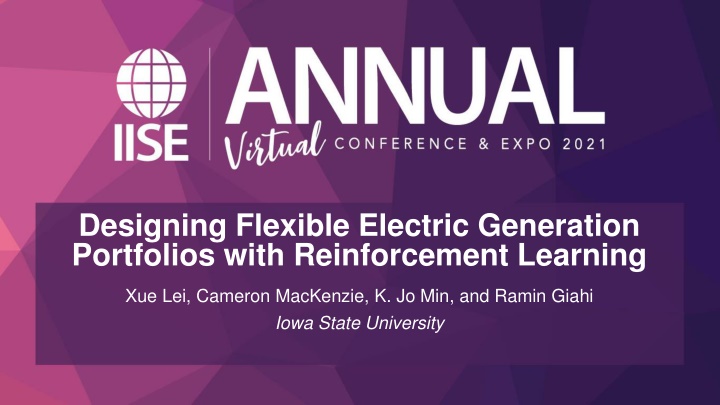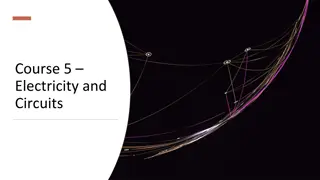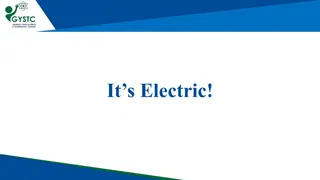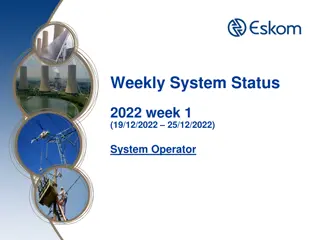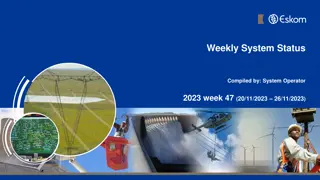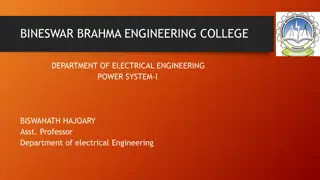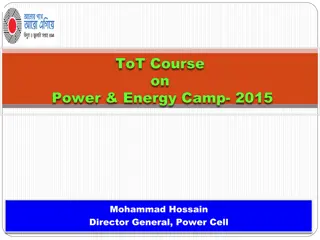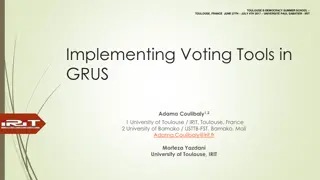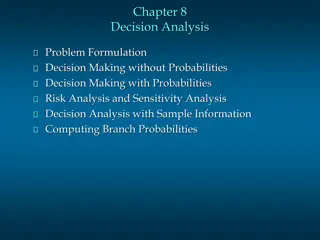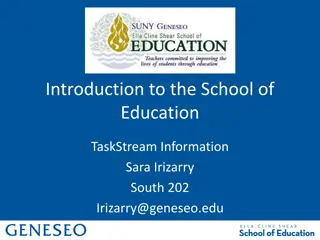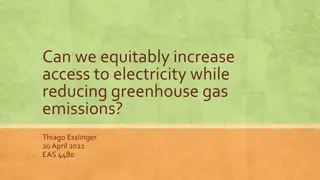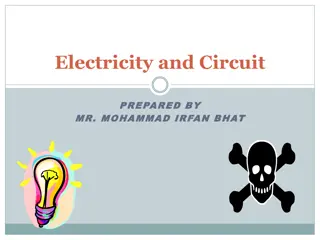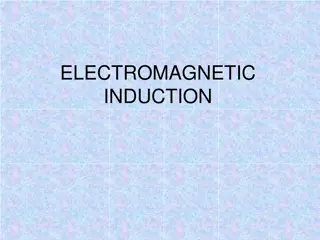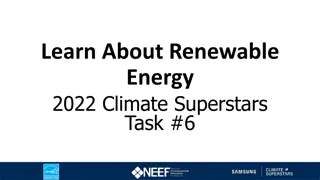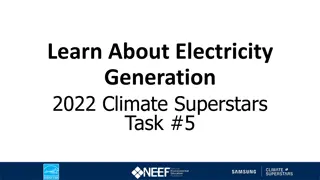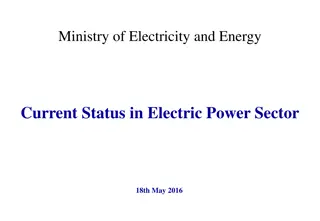Dynamic Decision Making for Electricity Generation Portfolios
Challenges in designing flexible electric generation portfolios are addressed using reinforcement learning. Uncertainties in future planning, carbon emission limits, and renewable energy sources are considered to minimize costs and optimize capacity decisions. The research focuses on dynamic decision-making processes in complex engineering systems, aiming to apply reinforcement learning algorithms for efficient electricity generation strategies.
Download Presentation

Please find below an Image/Link to download the presentation.
The content on the website is provided AS IS for your information and personal use only. It may not be sold, licensed, or shared on other websites without obtaining consent from the author.If you encounter any issues during the download, it is possible that the publisher has removed the file from their server.
You are allowed to download the files provided on this website for personal or commercial use, subject to the condition that they are used lawfully. All files are the property of their respective owners.
The content on the website is provided AS IS for your information and personal use only. It may not be sold, licensed, or shared on other websites without obtaining consent from the author.
E N D
Presentation Transcript
Designing Flexible Electric Generation Portfolios with Reinforcement Learning Xue Lei, Cameron MacKenzie, K. Jo Min, and Ramin Giahi Iowa State University
Designing flexibility in electricity generation Designing flexibility in electricity generation Industrial and Manufacturing Systems Engineering, Iowa State University 2
Challenges in planning for the future Challenges in planning for the future Uncertainties Demand Costs (investment, fuel) Requirements for using renewable sources Future carbon emission limit Planning for very long time horizons (~40 years) Need to make decisions at different stages Monte Carlo simulation can integrate the uncertainties but making decisions with these uncertainties encounters curse of dimensionality Industrial and Manufacturing Systems Engineering, Iowa State University 3
Dynamic decision making with reinforcement Dynamic decision making with reinforcement learning learning R. Giahi, Sequential decision making and simulation-optimization for the design of complex engineering systems Decisions made at different stages Monte Carlo simulation used to evaluate objective function at each stage Deep-Q reinforcement learning algorithm Proof of concept (capacity expansion problem over 5 stages) Research goal: Apply reinforcement learning algorithm to dynamic decision problem for electricity generation R. Giahi, 2020. Sequential decision making and simulation-optimization for the design of complex engineering systems. PhD Dissertation, Iowa State University. https://lib.dr.iastate.edu/etd/18317/ Industrial and Manufacturing Systems Engineering, Iowa State University 4
Problem outline Problem outline Decision variables: Choose capacity for each electricity technology at each stage Objective: Minimize total discounted cost Investment Operations and maintenance Cost of fuel generation Salvage value Constraints Capacity greater than demand Power flow equations Requirement that X% comes from renewable resources Limit on carbon emissions Limit on natural gas Could be uncertain Industrial and Manufacturing Systems Engineering, Iowa State University 5
Use neural network to choose capacity for subsequent stage Yes Algorithm Algorithm Randomly generate state at subsequent stage (e.g., demand, cost) Identify set of capacity alternatives that meet demand requirement Greedy policy? Randomly choose capacity for subsequent stage No No Capacity feasible for optimal power flow equations? Use neural network to simulate uncertainties and optimal policies Calculate objective function for capacity Store capacity, state, and objective in neural network Yes Industrial and Manufacturing Systems Engineering, Iowa State University 6
Application Application Mejia-Giraldo and McCalley, Maximizing future flexibility in electric generation portfolios 5 regions 14 generation technologies 40-year time horizon divided into 20 stages 10 representative scenarios (clustering algorithm) 10,000 scenarios (reinforcement learning and neural network) 1 region 2 technologies: natural gas and wind 5 stages D. Mejia-Giraldo and J.D. McCalley, 2014. Maximizing future flexibility in electric generation portfolios, IEEE - Transactions on Power Systems 29(1): 279-288. Industrial and Manufacturing Systems Engineering, Iowa State University 7
Uncertainties Uncertainties Demand: increases each year but two different rates of increase Cost of fuel generation for gas: increases each year but two different rates Cost of investment for wind: decreases each year but two different rates Industrial and Manufacturing Systems Engineering, Iowa State University 8
Stage 1 (Gas, Wind) Stage 2 Demand Stage 2 (Gas, Wind) Stage 3 Demand Stage 3 (Gas, Wind) Stage 4 Demand Stage 4 (Gas, Wind) Stage 5 Demand Stage 5 (Gas, Wind) 135 (0, 2) All units in gigawatts 133 (0, 2) 136 (0, 3) 132 (0, 2) 136 (0, 2) 134 (0, 3) 137 (0, 4) 130 (0, 2) 136 (0, 2) 134 (0, 2) 137 (0, 4) 133 (0, 3) 137 (0, 2) 136 (0, 4) 139 (0, 3) (34, 20) 136 (0, 2) 134 (0, 2) 137 (0, 4) 133 (0, 2) 137 (0, 2) 136 (0, 4) 139 (0, 3) 131 (0, 3) 137 (0, 2) 136 (0, 2) 139 (0, 3) 134 (0, 4) 139 (0, 2) 137 (0, 3) 140 (0, 4) Industrial and Manufacturing Systems Engineering, Iowa State University 9
Preliminary conclusions and future work Preliminary conclusions and future work Preliminary conclusions Incorporating optimal power flow conditions into dynamic decision making with uncertainty presents significant challenges (computational time) Myopic policy seems optimal Demand is only uncertainty that influences capacity decisions Future challenges Problem scale more decision variables, uncertainties, stages Improve algorithm efficiency Verify algorithm produces optimal solution Demonstrate usefulness compared to existing stochastic programming solutions Industrial and Manufacturing Systems Engineering, Iowa State University 10
Acknowledgements Acknowledgements Iowa Energy Center grant Diego Mejia-Giraldo for providing data file from his original study Contacts Cameron MacKenzie, camacken@iastate.edu Xue Lei, xlei@iastate.edu Industrial and Manufacturing Systems Engineering, Iowa State University 11
